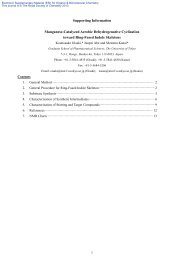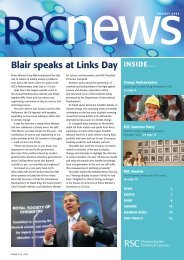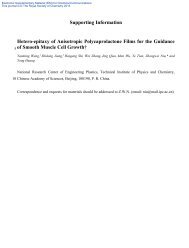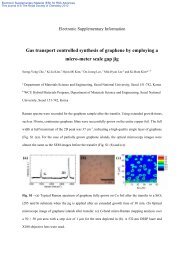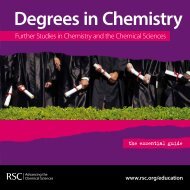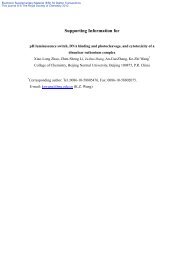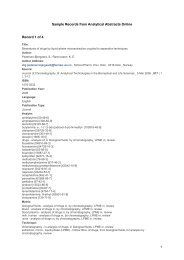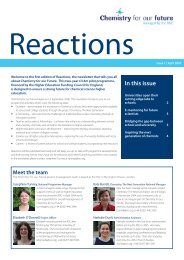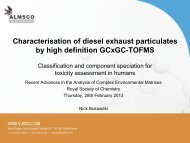Atom and molecule: upper secondary school French students ...
Atom and molecule: upper secondary school French students ...
Atom and molecule: upper secondary school French students ...
Create successful ePaper yourself
Turn your PDF publications into a flip-book with our unique Google optimized e-Paper software.
A. Cokelez <strong>and</strong> A. Dumon 132<br />
References<br />
Barlet R. <strong>and</strong> Plouin D. (1997), La dualité microscopique-macroscopique: un obstacle sous-jacent aux<br />
difficultés en chimie dans l’enseignement universitaire, ASTER, 25, 143-173.<br />
Ben-Zvi R., Eylon B. <strong>and</strong> Silberstein J. (1988), Theories, principles <strong>and</strong> laws, Education in<br />
Chemistry, 25, 89-92<br />
Charlet-Brehelin D. (1998), Contribution à l’enseignement - apprentissage du concept d’atome au<br />
collège, Thèse, Université Montpellier II.<br />
De Vos, W. <strong>and</strong> Verdonk A.H. (1987), A new road to reaction. Part 4. The substances <strong>and</strong> its<br />
<strong>molecule</strong>s, Journal of Chemical Education, 64, 692-695.<br />
Driver R. <strong>and</strong> Easley J., (1978), Pupils <strong>and</strong> paradigms: a review of literature related to concept<br />
development in adolescent science <strong>students</strong>, Studies in Science Education, 5, 61-84.<br />
Gilbert J.K. <strong>and</strong> Swift D.J., (1985), Towards a Lakatosian analysis of the Piagetian <strong>and</strong> the alternative<br />
conceptions research programs, Science Education, 69, 681-696.<br />
Gilbert J.K., Osborne R.J. <strong>and</strong> Fensham P.J., (1982), Children's science <strong>and</strong> its consequences for<br />
teaching, Science Education, 66, 623-633.<br />
Giordan A. <strong>and</strong> De Vecchi G. (1987), Les origines du savoir, Delachaux <strong>and</strong> Niestlé, Neuchâtel -<br />
Paris.<br />
Griffiths K. A. <strong>and</strong> Preston R. K., (1992), Grade-12 <strong>students</strong>’ misconceptions relating to fundamental<br />
characteristics of atoms <strong>and</strong> <strong>molecule</strong>s, Journal of Research in Science Teaching, 29, 611-628.<br />
Harrison A.G. <strong>and</strong> Treagust D.F., (1996), Secondary <strong>students</strong>’ mental models of atoms <strong>and</strong> <strong>molecule</strong>s:<br />
implications for teaching chemistry, Science Education, 80, 509-534.<br />
Harrison A.G. <strong>and</strong> Treagust D.F., (2000), Learning about atoms, <strong>molecule</strong>s, <strong>and</strong> chemical bonds: a<br />
case study of multiple-model use in grade 11 chemistry, Science Education, 84, 352-381.<br />
Johnston K., (1988), Learning <strong>and</strong> teaching about the particulate theory of matter: a report on a<br />
teaching scheme in action, in proceeding of a bi-national UK-Israel seminar: Learning difficulties<br />
in chemistry, Jerusalem, 55-79.<br />
Justi R. <strong>and</strong> Gilbert J., (2000), History <strong>and</strong> philosophy of science through models: some challenges in<br />
the case of ‘the atom’, International Journal of Science Education, 22, 993-1009.<br />
Keig F.P. <strong>and</strong> Rubba A.P., (1993), Translation of representations of the structure of matter <strong>and</strong> its<br />
relationship to reasoning, gender, spatial reasoning, <strong>and</strong> specific prior knowledge, Journal of<br />
Research in Science Teaching, 30, 883-903.<br />
Laugier A. <strong>and</strong> Dumon A., (2000), Histoire des sciences et modélisation de la transformation<br />
chimique, Bulletin de l'Union des Physiciens, 826, 1261-1284.<br />
Niaz M., Aguilera D., Maza A. <strong>and</strong> Liendo G., (2002), Arguments, contradictions, resistances <strong>and</strong><br />
conceptual change in <strong>students</strong>' underst<strong>and</strong>ing of atomic structure, Science Education, 86, 505-<br />
525.<br />
Osborne, R. <strong>and</strong> Freyberg P., (1985), Learning in science: the implications of children’s science,<br />
Auckl<strong>and</strong>:Heineman. (in Griffiths <strong>and</strong> Preston, 1992, p. 612 ).<br />
Pereira M.P. <strong>and</strong> Pestana M.E.M., (1991), Students’ representations of models of water, International<br />
Journal of Science Education, 13, 313-319.<br />
Robinson W.R., (1998), An alternative framework for chemical bonding, Journal of Chemical<br />
Education, 75, 1074.<br />
Taber K.S., (1998), An alternative conceptual framework from chemistry education, International<br />
Journal of Science Education, 20, 597-608.<br />
Taber, K. S., (2003), The atom in the chemistry curriculum: fundamental concept, teaching model or<br />
epistemological obstacle?, Foundations of Chemistry, 5, 43-84.<br />
Taber K.S., (2004), Learning quanta: barriers to stimulating transitions in student underst<strong>and</strong>ing of<br />
orbital ideas, Science Education, 89, 94-116.<br />
Toomey R., DePierro E. <strong>and</strong> Garafalo F., (2001), Helping <strong>students</strong> to make inferences about the<br />
atomic realm by delaying the presentation of atomic structure, Chemistry Education Research<br />
<strong>and</strong> Practice, 2, 129-144.<br />
Tsai C.C., (1998), An analysis of Taiwanese eighth graders’ science achievement, scientific<br />
epistemological beliefs <strong>and</strong> cognitive structure outcomes after learning basic atomic theory,<br />
International Journal of Science Education, 20, 413-425.<br />
Chemistry Education Research <strong>and</strong> Practice, 2005, 6 (3), 119-135<br />
This journal is © The Royal Society of Chemistry




